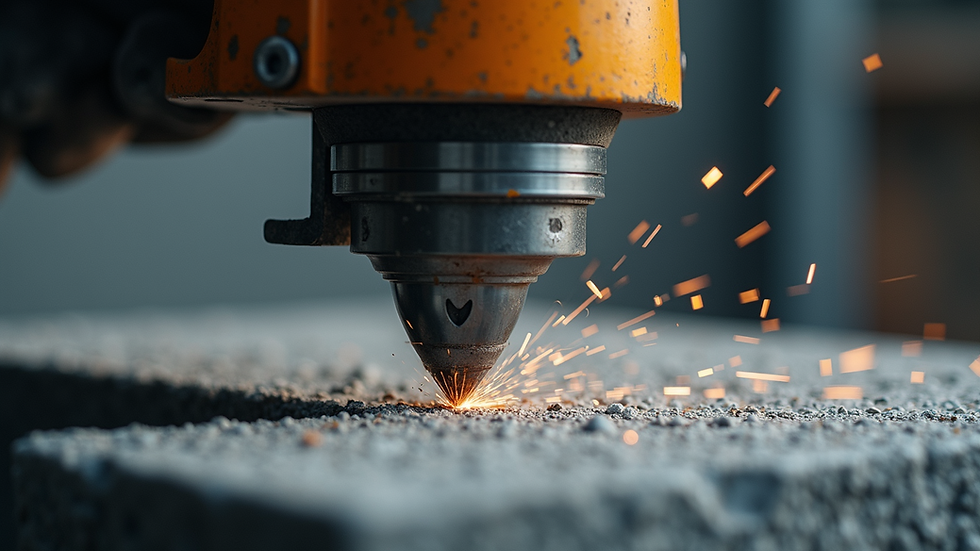Optimizing Results with Diamond Grinding Wheels
- Philix Chen

- Oct 15
- 3 min read
In industries such as construction, mining, and manufacturing, precision and efficiency in material processing are critical. One tool that consistently delivers on these demands is the diamond grinding wheel. Its unique properties allow for superior cutting, grinding, and shaping of hard materials. In this article, I will explore how to optimize results when using diamond grinding wheels, focusing on their applications, operational tips, and maintenance practices.
Understanding Diamond Grinding Wheel Applications
Diamond grinding wheels serve a variety of purposes across multiple sectors. Their primary advantage lies in the hardness and durability of diamond abrasives, which outperform conventional grinding materials. These wheels are particularly effective for processing hard and brittle materials such as concrete, ceramics, glass, and various metals.
Some common applications include:
Surface preparation: Smoothing and leveling concrete floors before applying coatings or finishes.
Tool sharpening: Reshaping and sharpening cutting tools and drill bits.
Material removal: Efficiently removing excess material or defects from workpieces.
Precision grinding: Achieving tight tolerances in manufacturing components.
The versatility of these wheels makes them indispensable in tasks requiring high precision and durability. Selecting the right wheel specification—such as grit size, bond type, and wheel shape—is essential to match the application and material.

What are diamond grinding wheels used for?
Diamond grinding wheels are engineered to handle materials that are difficult to machine with traditional abrasives. Their applications extend to:
Concrete and masonry grinding: Removing coatings, leveling uneven surfaces, and preparing floors for further treatment.
Stone fabrication: Shaping and finishing natural and engineered stone products.
Metalworking: Grinding hard metals like carbide, hardened steel, and superalloys.
Glass and ceramics: Cutting and grinding brittle materials without causing cracks or chips.
In mining, these wheels assist in shaping and maintaining cutting tools used for extracting minerals. In manufacturing, they contribute to producing components with precise dimensions and smooth finishes. The ability to maintain sharpness and resist wear makes diamond grinding wheels cost-effective over time.

Tips for Optimizing Performance with Diamond Grinding Wheels
To maximize the efficiency and lifespan of diamond grinding wheels, consider the following best practices:
Choose the correct wheel specification
Match the wheel’s grit size, bond type, and hardness to the material and task. For example, softer bonds are better for hard materials to expose fresh diamonds, while harder bonds suit softer materials.
Maintain proper wheel speed and feed rate
Operating at the recommended speed prevents overheating and premature wear. Adjust feed rates to avoid excessive pressure that can damage the wheel or workpiece.
Use adequate cooling
Applying coolant or water reduces heat buildup, which can degrade the bond and cause wheel glazing. Proper cooling also improves surface finish quality.
Dress the wheel regularly
Dressing removes clogged material and exposes new abrasive grains, maintaining cutting efficiency. Use a diamond dresser compatible with the wheel.
Inspect for damage before use
Check for cracks, chips, or uneven wear. Using a damaged wheel risks poor performance and safety hazards.
Ensure proper mounting and balancing
Secure the wheel correctly on the spindle and balance it to minimize vibration, which affects precision and tool life.
By following these guidelines, you can achieve consistent results and extend the operational life of your grinding wheels.

Maintenance and Safety Considerations
Regular maintenance is crucial for both performance and safety when working with diamond grinding wheels. Here are key points to keep in mind:
Storage: Store wheels in a dry, temperature-controlled environment to prevent damage to the bond.
Cleaning: Remove debris and residue after each use to prevent clogging.
Personal protective equipment (PPE): Always wear safety glasses, gloves, and respiratory protection to guard against dust and flying particles.
Training: Ensure operators understand the correct handling, mounting, and operational procedures.
Replacement: Replace wheels that show signs of excessive wear or damage to avoid accidents.
Implementing a maintenance schedule and safety protocols reduces downtime and enhances workplace safety.
Future Trends in Diamond Grinding Wheel Technology
Advancements in materials science and manufacturing techniques continue to improve diamond grinding wheel performance. Innovations include:
Enhanced bond materials: New resin and metal bonds increase wheel durability and cutting speed.
Segmented and turbo designs: These improve cooling and debris removal during grinding.
Customized wheels: Tailored abrasive distributions and shapes optimize performance for specific applications.
Integration with automation: Smart grinding systems monitor wheel condition and adjust parameters in real time.
Companies like Hans Flexible Diamond Wire Saw Co.,Ltd focus on perfecting these technologies to meet evolving industrial needs. Their commitment to innovation supports expanding applications and improved efficiency in cutting and grinding operations.
By understanding the applications, operational best practices, and maintenance requirements of diamond grinding wheels, industries can optimize their material processing tasks. Using the right tools and techniques ensures precision, efficiency, and safety in demanding environments.
For more detailed information on advanced diamond grinding solutions, visit diamond grinding wheel.










Comments